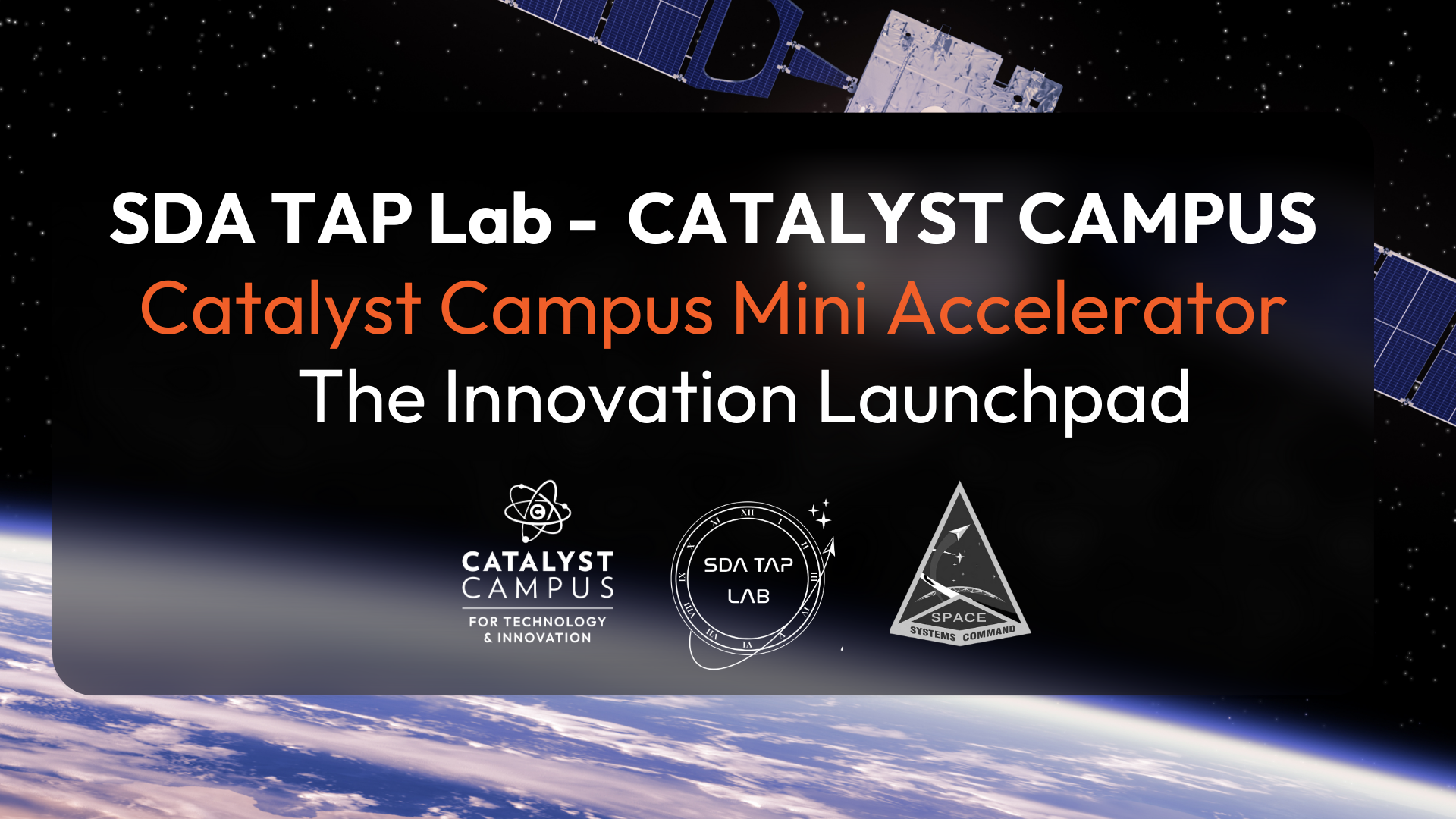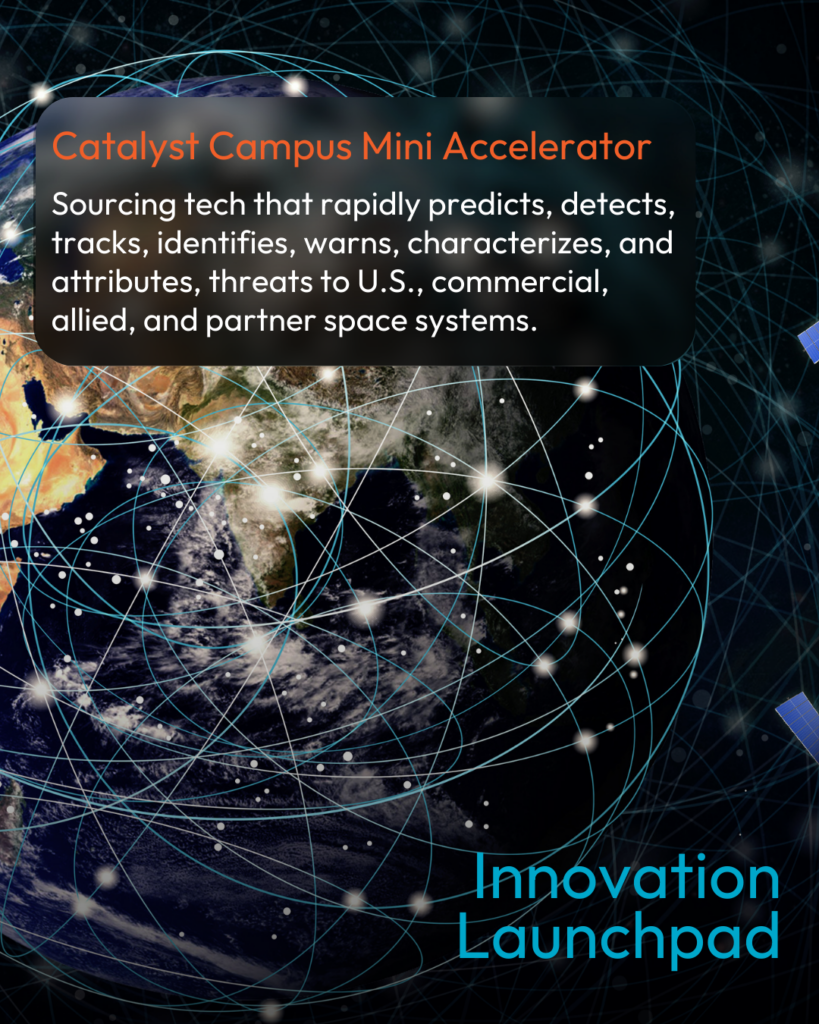
The SDA TAP Lab Mini Accelerator is a high-impact program designed to support early-stage companies in rapidly developing and refining technology solutions for Space Domain Awareness (SDA). Over two-month cycles, it provides participants with intensive mentorship, technical workshops, and access to cutting-edge data and computational resources. The program focuses on addressing specific SDA problem statements by fostering collaboration with operators and aligning solutions with real-world needs.
By offering a streamlined path from prototype development to integration into the Project Apollo Accelerator, the Mini Accelerator creates a continuous pipeline of innovative technologies ready for national defense applications. Through this program, companies are equipped to meet critical space and cybersecurity challenges while strengthening Colorado’s role as a leader in aerospace innovation.
SDA TAP Lab - Catalyst Campus Mini Accelerator AMA Video
MINI ACCELERATOR COHORT 1
MARCH 3 - MAY 2
Pitch Days will be February 20th and 21st.
Programming dates are 3 March – 2 May with in-person dates of 10-21 March.
Each Catalyst Campus Mini Accelerators will be working with companies working to solve problems that correspond to the SDA TAP Lab’s problem sets being addressed in Project Apollo.
Problem Sets:
SDA TAP Lab Problem 1: Using commercial or public imagery, detect the start of a space launch cycle automatically.
SDA TAP Lab Problem 3: Using seismic data, commercially available cell-phone accelerometer data, or weather data, detect the time and location of foreign space launches automatically.
SDA TAP Lab Problem 7: Using orbital data and/or knowledge of sensors and satellites, develop a sensor search technique that maximizes the probability of reacquiring a satellite or space launch vehicle. The technique must be valid for ground or space based EO, IR, RF, or RADAR sensors.
SDA TAP Lab Problem 9: Using orbital data, develop a specialized technique to process uncorrelated tracks (UCTs) and promote candidate orbits generated from UCTs which may actively manage their optical or radar signatures or otherwise be evading detection, tracking, and identification.
SDA TAP Lab Problem 11: Using orbital data, automatically detect separation events and classify them as either 1) sub-satellite deployment, 2) Debris generating event. Further sub-classify debris generating events, as either: Shedding, Explosion, Impact
SDA TAP Lab Problem 16: Since we assume surprise may come through camouflage, concealment, deception or maneuver (CCDM) we must interrogate targets for evidence of CCDM. Develop techniques to evaluate whether combinations of the following are true of UCT candidate orbits, or satellites in a catalog classified as unknown (UNK), debris (DEB), rocket body (R/B), or an inactive payload:
- Object is stable
- Stability has changed
- Maneuvers detected
- Radio Frequencies (RF) detected
- Sub-satellites have deployed
- Maneuvers or RF pattern-of-life (POL) is out of family
- Violates stated ITU or FCC filings
- Class disagreement between analysts
- Orbit is out of family
- Optical or RADAR signature out of family
- Add shape stuff
- Optical and RADAR signature mismatch
- Object appears to be stimulated by US, allied, or partner systems
- Area-to-mass ratio (AMR) is out of family
- Notable changes to AMR
- Proximity events appear to be valid remote-sensing passes
- Maneuvers resulted in valid remote-sensing passes (“”imaging maneuvers””)
- Imaging maneuvers are also POL violations
- Object maneuvers in sensor coverage gaps
- Number of objects tracked from launch is greater than expected
- Object came from launch site or vehicle known to deploy threats
- UNK/DEB has semi-major axis (SMA) higher than parent satellite
- True uncorrelated track (UCT) while object is in eclipse
- Object is in a relatively unoccupied orbit
- Object is in a relatively high radiation environment
- Object is not in United Nations (UN) satellite registry
- Other

The Mini Accelerator serves as the essential launch pad for familiarizing participants with the technologies and processes utilized by the SDA TAP Lab.
By providing hands-on training and aligning solutions with operational needs, it ensures companies are fully prepared to seamlessly transition into the Project Apollo Accelerator for advanced development and deployment.
